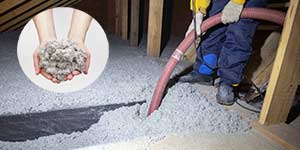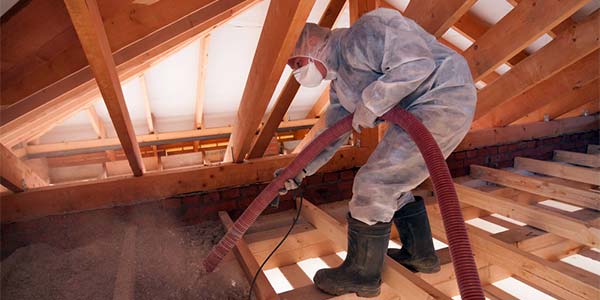St Louis - St Charles Insulation Company.


Insulation That Is Environmentally Friendly
Most homeowners these days are eco-conscious and want to make wise choices when it comes to the materials and products they use in their houses. Insulation is no different. The right eco-friendly insulation will keep you comfortable, save you money and lower your carbon footprint.
The goal of all insulation, regardless of type, is to reduce heat loss in winter and reduce heat gain in summer. This not only helps your home become more efficient, it allows you to save money on your energy bills – not to mention reduce the emissions that come with heating and cooling your home. However, not all insulation is created equal. Some types are better than others at providing eco-friendly benefits.
So, what is the most eco-friendly insulation?
Cellulose Insulation
Long considered to be the most environmentally friendly, cellulose insulation and blown-in cellulose Insulation is comprised of 80 to 85 percent recycled newsprint. The rest consists of borax, boric acid or ammonium sulfate, which adds to the product’s fire resistance. Plus, borate-based flame retardants also keep insects at bay. Best of all, cellulose is safe to use in either a residential or commercial setting and poses no threat to occupants.
This type of insulation tends to be more eco-friendly than other materials, with R-values of R-3.5 per inch, which is similar to fiberglass. However, cellulose boasts a higher percentage of recycled content, making it a win-win for the environment.
Cellulose is a loose-fill product that is blown into a space. Insulation contractors in St. Louis MO use special machines to blow it into place. It’s very versatile, as it can be installed in open attic floors or in existing walls without the need for destroying the walls. That’s because cellulose can be blown through small holes in the desired area, making it the least invasive option.
Spray Foam Insulation
Spray foam is another efficient insulation material, with an R-value of up to R-6.5 per inch. This environmentally friendly material is sprayed into place by a gun. The two main compounds -- polyurethane and Isocyanate foams -- react when sprayed to produce a strong, durable and space-conforming material that lasts for decades. It can be sprayed into wall cavities of finished and unfinished walls as well as into holes and crevasses without damaging the walls.
If you want to be extra eco-friendly, there are polyurethane spray foams out there that are made from soy or vegetable oil rather than petroleum. Whether you choose open cell or closed cell spray foam, the benefits are many. It’s energy efficient, it acts as a barrier to moisture, and it’s easy to install.
Call Insulation Specialist in St. Charles MO
To book a consultation on which eco-friendly insulation type is right for you, get in touch with our trustworthy insulation contractors in St. Louis MO at 636-233-7314.
Energy Saving BlogPopular Articles
- FAQs About Insulation in Missouri
- What Areas Should You Insulate Before Winter?
- The Greatest Risks to Your Home Caused by Poor Insulation
- Why Your Utility Bills Are So High and What You Can Do About It
- Can You Put New Insulation Over Old?
- Here Are 3 Ways Your Attic Could be Contaminated
- How Home Insulation Works in the Summer
- Tips and Tricks For Summer Insulation
- How to Fix Indoor Condensation
- Choosing the Right Spray Foam Contractor
- Why You Need Power Washing This Spring
- Don't Let Air Escape Your Home
- Tips For Saving on Your Energy Bills This Summer
- Should I Install a Radiant Barrier in My Home?
- Are You Wondering if Your Attic Has Enough Insulation?
- Do I Have to Replace Wet Insulation?
- Insulating Your Sunroom
- Should You Insulate Your Outdoor Spaces?
- All About Removing Insulation
- What to Know About Insulating a Crawl Space
- How to Spot Mold in Your Wall Insulation
- How to Prevent Moisture in Your Warehouse With Spray Foam Insulation
- What Factors Cause Heat Gain?
- The Problems That Come With Improper Insulation
- Insulation FAQs
- Why Should You Check the Insulation When Buying a Home?
- Why Seal and Insulate Your Home?
- Home Insulation: Safety and Health
- Should You Remove Old Insulation During Replacement?
- Can I Stay Inside My Home During Spray Foam Insulation Installation?
- Pros and Cons of Converting an Attic
- Pros and Cons of Converting an Attic
- When’s the Best Time to Insulate Your House?
- The Difference Between Blown Insulation and Spray Foam Insulation
- Is Your Garage Loft Too Hot or Too Cold? Heed These Tips
- 6 Health Benefits of Having a Quiet Home
- Insulation Prep is Critical For Installation
- The Dangers of Removing Insulation on Your Own
- What’s the Most Eco-Friendly Insulation?
- 7 Benefits of Spray Foam Insulation
- What is the Proper Insulation For Vaulted Ceilings?
- Signs Your Crawlspace Insulation Should be Replaced
- Why You Should Insulate Your Basement Walls
- Most Effective Ways to Soundproof Your Home Office
- How to Insulate an Old House
- 4 Tips to Make Your Attic More Energy Efficient
- Attic Insulation Problems: 5 Things to Look Out For
- What Causes Condensation on Interior Walls?
- How Deep Should Your Insulation Be?
- What to Consider When Choosing an Insulation Company
- Can You Add New Insulation Layers Over Old Ones?
- When Should You Remove Insulation?
- 7 Tips For an Energy Efficient Summer
- Creating a Healthy, Comfortable and Productive Workspace When Working From Home
- Why is Roof Ventilation Just as Important as Insulation?
- Why Spring is a Good Time to Insulate Your Attic
- 5 Signs of Damaged or Insufficient Insulation
- Is the Insulation in Your Walls Making You Sick?
- Under-Insulated Areas You May Be Overlooking
- The History Of Insulation.
- Pros and Cons of Attic Insulation
- Do You Need Insulation When Finishing a Basement?
- What is Drill and Fill Insulation?
- Which Insulation is Best for Garage Walls?
- How Air is Escaping Your Home and How to Prevent It
- 10 Things You Must Absolutely Insulate Before Winter
- 5 Reasons To Not DIY Insulation
- 5 Signs of an Under-Insulated Home
- 5 Benefits of Blown Insulation
- Cellulose vs. Fiberglass Insulation
- When is Insulation Removal Necessary?
- Tips to Keep Your Home Cool This Summer
- What is the Best Insulation for a Flat Roof?
- 5 Benefits of Power Washing
- Q & A About Insulation
- Reviews
- Energy Saving Blog






